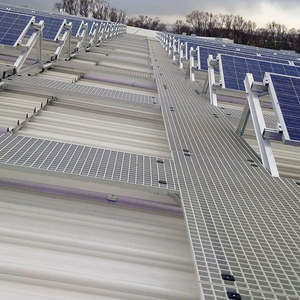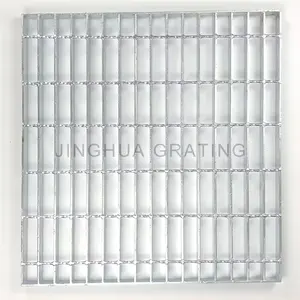(259 products available)


























































































































































An inlet grate is a cover installed over an inlet to protect debris from entering the stormwater pipe. It is also known as a trench grate or drain grate. Inlet grates come in different types based on design and use. Here are some of the common types of inlet grates:
Slotted grate:
A slotted grate has long slots that allow water to flow freely into the drain while filtering debris. The slots on the grate can be vertical or diagonal. A slotted grate is popular because it has high hydraulic efficiency. It is also easy to install and maintain. However, this type of inlet grate is more suitable for areas with low debris and sediment. The narrow slots may not trap large objects.
Bar grate:
A bar grate has parallel bars that form a grid pattern. The design of the grate allows water to flow easily into the drainage system while trapping large debris. Bar grates are strong and durable. They are also easy to clean. However, this type of grate has low hydraulic efficiency. Water may flow slowly in areas with multiple bars.
Square grate:
A square grate has a diamond or square pattern. The design ensures water enters the drainage system and large debris are filtered out. This type of inlet grate is popular because it has high strength and stability. It has a slip-resistant surface that prevents accidents. However, this grate has low hydraulic efficiency compared to other types. It is also difficult to clean.
Round grate:
A round grate is shaped like a circle. It is popular for its strength and ability to disperse pressure evenly. A round grate prevents dirt and large debris from entering the stormwater pipe. This type of inlet grate is common in urban areas. It has a high hydraulic efficiency and is easy to maintain. However, a round grate is more expensive and difficult to install. It requires precise calculations.
Heavy-duty grate:
These are strong and durable grates that can withstand harsh conditions. They are made from stainless steel or cast iron. These materials can resist corrosion and rust. This type of grate is popular in industrial areas or locations with high traffic. They can filter large volumes of water and debris. However, these grates are heavy and expensive. They may have low hydraulic efficiency.
As mentioned above, water is collected from the surface and directed into a drainage system through inlets. Some features of these inlets are listed below:
Load Capacity
The load capacity of an inlet grate determines where the grate can be placed. For example, residential areas have lower load ratings than commercial or industrial areas. Grates placed in industrial and commercial areas must withstand heavy loads from vehicles and foot traffic.
Materials
The materials used to manufacture inlet grates affect the durability and strength of the grates. Common materials include polymer concrete, galvanized steel, ductile iron, stainless steel, and aluminum. Polymer concrete is lightweight and usually used in residential areas. Stainless steel and aluminum are corrosion-resistant and lightweight. Ductile iron and galvanized steel are strong and durable.
Styles and Designs
There are many different styles and designs of inlet grates. The most popular include slotted, decorative, trench, and heavy-duty grates. Decorative grates are aesthetically pleasing and used in areas where drainage is needed but not heavy traffic. Heavy-duty grates are used in industrial and commercial areas and are made of strong materials like cast iron. Slotted grates have slots that direct water into the inlet, while trench grates cover a large area and are good for areas that experience a lot of rainfall.
Safety Features
Some inlet grates have safety features, including anti-slip surfaces and load ratings. Anti-slip surfaces prevent slips and falls, while load ratings inform users of the weight the grate can withstand. Other safety features include child safety locks and locking systems, which prevent accidents and unauthorized access.
Customization Options
There are many different types of inlet grate customization options. These include size, shape, material, load rating, and style. Other customization options include finish and engraving. Finish customization involves matching the inlet grate to the landscape or drainage area. Engraving involves adding a logo or text to the grate.
Inlet grates serve different applications in different industries. Here are some of the applicable industries:
Construction
Construction companies use inlets to control and manage stormwater runoff. This is done by preventing debris and sediments from entering the drainage system. It enhances water quality by filtering stormwater runoff.
Inlet grates are also used to manage flooding in construction sites. They provide a safe and effective means of transporting water to underground storage or drainage. This minimizes water accumulation in construction sites.
Telecommunication
Telecommunication companies use inlets to protect underground utilities. The grates prevent soil, debris, and other materials from entering and damaging telecom infrastructure. This ensures proper functioning and longevity of the telecom networks.
Agriculture
Farmers and agricultural specialists use inlet grates to prevent erosion. They ensure that sediments and soil remain in the water runoff. This minimizes water runoff and erosion in farmlands.
Farmers also use inlet grates to manage water irrigation. The grates filter and transport water to irrigation canals and systems. This ensures the efficient and effective transport of water to irrigation systems.
Municipalities
Municipalities use inlet grates in urban areas to control and manage stormwater runoff. The grates prevent flooding and water pooling in streets and other urban areas. They also prevent the entry of debris into the stormwater system.
They also use inlet grates in parks and other public areas. The grates are aesthetically pleasing and blend well with the environment. This provides a functional and practical solution to stormwater management.
Size and dimension:
Considering the size and dimension of the inlet and outlet grate should be the first thing a buyer looks at before making any purchases. Each water drain has its own size, and buyers should measure their water drain and select a drain grate that will fit perfectly into their drain outlet.
Material durability:
Another important thing to consider is the material used to construct the inlet grate. This is important because different types of grates are made with different materials and come in different finishes. Some materials will rust easily, while others are resistant to harsh weather conditions and rust.
Load capacity:
It is important to choose a drainage grate that can withstand pressure and weight. This is because some areas are used more than others, and choosing a grate that can withstand that pressure is very important.
Water flow:
One of the main reasons for installing a drain grate is to allow water to flow freely. So, when choosing an inlet grate, it is important to consider the water flow rate to prevent flooding in the area.
Aesthetic and design:
For areas like patios, walkways, and driveways, it is important to consider the style and design of the grate. This is to ensure that it complements the existing décor and design of the landscape.
Maintenance:
Drainage grates are installed to prevent dirt and debris from entering the water drain. As such, they need to be cleaned regularly to prevent dirt from piling up. So, when choosing a grate, it is important to consider the one that is easy to maintain and clean out.
Q1: How to maintain inlet grates?
A1: Regularly cleaning the grates to prevent clogging and checking for any damages.
Q2: What is the role of a drain in a stormwater system?
A2: A stormwater drain helps transport runoff water from rainfall or storms to prevent flooding. It collects and channels the water efficiently through inlet areas and the drain itself.
Q3: Are grates recyclable?
A3: Most types, including galvanized and steel grates, are recyclable. Contact a local recycling center to learn more about the recycling process.
Q4: Do the types of grates affect drainage?
A4: Yes, different types have varying drainage capabilities. Open mesh patterns offer higher flow rates than solid covers, especially in heavy rain.
Q5: How are grates installed?
A5: The grate is placed over the inlet opening and secured using bolts or other locking mechanisms. It is essential to ensure there are no gaps between the grate and the inlet to prevent debris from entering the stormwater system.